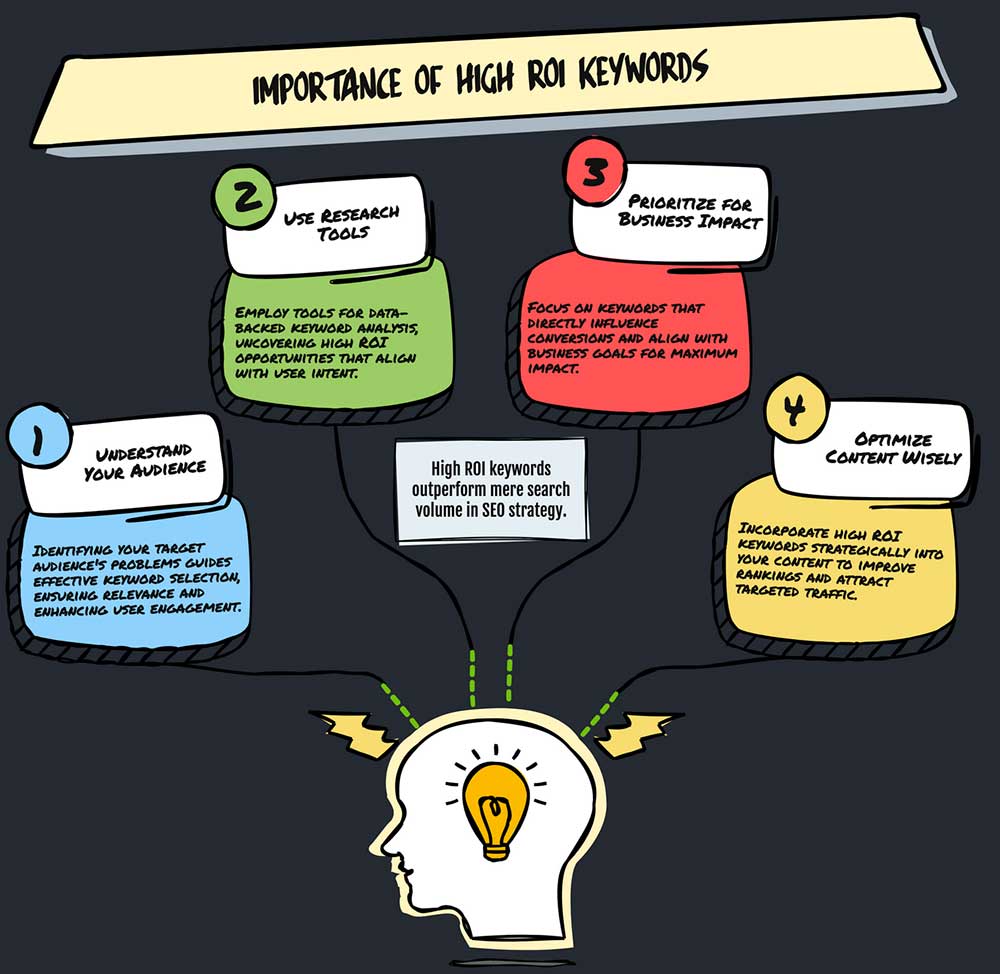When it comes to SEO, not all keywords are created equal. Some drive massive traffic but convert at a painfully low rate. Others may have modest search volume but bring in leads that turn into high-value customers. The key to a winning SEO strategy isn’t just ranking for any keyword; it’s ranking for the right ones. In this article, I’ll walk you through how to identify high ROI keywords that maximize organic traffic and revenue.
Why High ROI Keywords Matter More Than Search Volume
Many businesses fall into the trap of chasing high-volume keywords. It makes sense on the surface; more searches mean more potential visitors, right? The problem is that broad, competitive terms often bring in unqualified traffic. If those visitors aren’t converting, what’s the point?
High ROI keywords are different. These are the search terms that bring in traffic with intent; people looking for exactly what you offer. They may have lower search volume, but they drive action: conversions, sales, and long-term customers. Finding these keywords is the difference between an SEO strategy that looks good on paper and one that actually grows your business.

Step 1: Understand Your Audience and Their Search Intent
Before diving into keyword research tools, take a step back and think about your ideal customer. What problems are they facing? What solutions are they searching for? High ROI keywords align directly with user intent, which typically falls into these categories:
- Informational: Users looking for knowledge (e.g., “how to choose the right CRM”)
- Navigational: Users searching for a specific brand or website (e.g., “HubSpot CRM reviews”)
- Transactional: Users ready to make a purchase or decision (e.g., “best CRM for small businesses”)
- Commercial Investigation: Users comparing options before a decision (e.g., “HubSpot vs. Salesforce CRM”)
Your goal is to focus on transactional and commercial investigation keywords, as these are the ones most likely to convert.
Step 2: Use Keyword Research Tools to Uncover High ROI Opportunities
While brainstorming is a great starting point, you’ll need data to validate your assumptions. Here’s how to dig deeper:
1. Google Search Console
Look at the queries that are already driving traffic to your site. You may find hidden gems—keywords where you’re ranking on page two that could be optimized for page one.
2. Google Ads Keyword Planner
Even if you’re focused on organic traffic, Google Ads data is invaluable. Check cost-per-click (CPC) and competition levels—high CPC keywords often indicate strong buyer intent, making them great targets for organic SEO.
3. SEMrush & Ahrefs
These tools help analyze:
- Keyword difficulty (how hard it is to rank)
- Search volume (how often it’s searched)
- Traffic potential (the estimated amount of traffic you’d get if you ranked in the top spots)
4. Competitor Analysis
Find out what’s working for your competitors by:
- Looking at their top-ranking pages and the keywords they rank for
- Using SEMrush, Ahrefs, or SpyFu to see what keywords they’re bidding on in PPC (if they’re paying for them, they’re probably valuable)
Step 3: Prioritize Keywords Based on Business Impact
Once you’ve built a list of potential keywords, the next step is prioritization. Here’s how to identify high ROI keywords that matter most:
1. Conversion Potential
- Does this keyword match your core product/service?
- Would someone searching for this likely convert?
2. Search Volume vs. Intent
- High-intent, low-volume keywords are often more valuable than high-volume, low-intent terms.
- Example: “Best marketing automation software for small business” (high intent) vs. “marketing software” (broad, low intent).
3. Competition & Ranking Feasibility
- If a keyword has high competition, consider long-tail variations that are easier to rank for.
- Example: Instead of “CRM software,” go for “best CRM for real estate agents.”
4. Revenue Impact
- Prioritize keywords that drive leads, purchases, or recurring revenue.
- If you’re an SEO consultant, a keyword like “SEO consultant for B2B tech companies” is far more valuable than “SEO tips.”
Step 4: Optimize Your Content for High ROI Keywords
Once you’ve identified the right keywords, it’s time to optimize your content. Here’s what to focus on:
1. On-Page SEO
- Include the keyword naturally in the title, meta description, and headers.
- Use variations and related terms to avoid keyword stuffing.
- Structure content to answer search intent clearly and concisely.
2. Internal Linking
- Link from other high-authority pages on your site to boost rankings.
- Use descriptive anchor text (e.g., “how to identify high ROI keywords” instead of “click here”).
3. Content Depth & Value
- Google prioritizes content that fully answers a query. Don’t just target a keyword—deliver value that keeps users engaged.
- Include examples, case studies, and real-world applications to strengthen your content.
Step 5: Track Performance & Refine Your Strategy
SEO isn’t set-it-and-forget-it. Track how your keywords are performing and adjust your strategy based on real data.
- Monitor rankings: Use Google Search Console or Ahrefs.
- Analyze conversion rates: Are visitors taking the desired action?
- Tweak & expand: Double down on what’s working and adjust or replace low-performing keywords.
Final Thoughts: Finding the Right Keywords is Just the Beginning
The foundation of SEO success isn’t just ranking—it’s ranking for keywords that matter. By identifying high ROI keywords, you’re not just driving traffic—you’re driving the right traffic.
If you’re ready to take your SEO to the next level and need expert guidance, let’s talk. Schedule a consultation and let’s build a strategy that turns your organic traffic into revenue.
Also, I’d love to connect with you on LinkedIn—let’s connect here!

